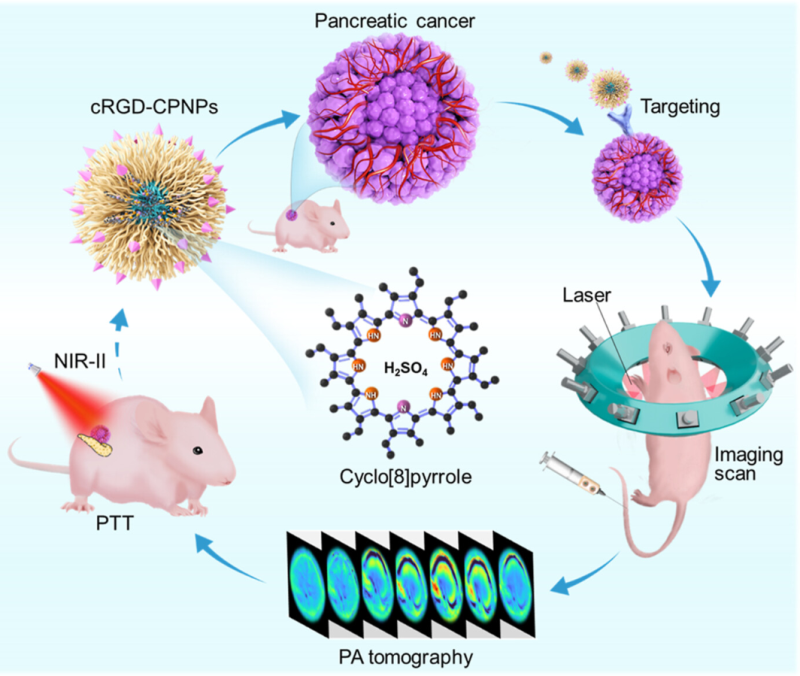On February 21, research teams led by Chengbo Liu and Jingqin Chen from the Shenzhen Institutes of Advanced Technology, Chinese Academy of Sciences; Jian Yang from Zhujiang Hospital, Southern Medical University; and Jonathan Sessler from the University of Texas at Austin jointly published a research paper titled "Targeted Cyclo[8]pyrrole-Based NIR-II Photoacoustic Tomography Probe for Suppression of Orthotopic Pancreatic Tumor Growth and Intra-abdominal Metastases" in the Journal of the American Chemical Society (Figure 1). This study utilized near-infrared II photoacoustic tomography (NIR-II PAT) to demonstrate that a cyclo[8]pyrrole-based targeted probe exhibits robust and stable photoacoustic and photothermal effects. The probe’s photothermal capabilities were further applied to inhibit the growth of orthotopic pancreatic tumors and intra-abdominal metastases.

Figure 1. Screenshot of the article's online publication
Pancreatic cancer is an extremely aggressive disease with a 5-year survival rate of approximately 10%, a statistic that has remained nearly unchanged over the past four decades. Most patients remain asymptomatic until the advanced stages of the disease, making early diagnosis challenging. Conventional medical imaging techniques such as X-ray computed tomography (CT), magnetic resonance imaging (MRI), and ultrasonography struggle to detect early-stage pancreatic tumors (lesion size <1 cm), underscoring the urgent need for novel early-diagnostic strategies to create therapeutic time windows. Molecular-level imaging technologies can effectively detect molecular and physiological changes occurring before anatomical alterations in tumors. After rapid advancements over the past decade, photoacoustic molecular imaging (PAM) has emerged as a pivotal technology in life sciences research and clinical medicine. By integrating optical and acoustic imaging with the multiplexing advantages of molecular markers, PAM enables non-invasive, cross-scale detection of structural, functional, and molecular pathological changes during tumor development, offering new opportunities for precise early diagnosis of pancreatic cancer and providing critical research tools.

Figure 2. Schematic illustration of a cyclo[8] pyrrole-based nanoprobe targeting pancreatic cancer in a mouse model
Porphyrins and their derivatives, widely found in nature (e.g., chlorophyll, heme), exhibit excellent biocompatibility. Chemically, the porphyrin backbone is a large heterocyclic compound composed of four pyrrole subunits, forming a 26-π-electron conjugated system. This structural feature endows porphyrins with advantages over traditional small-molecule dyes or inorganic probes in terms of safety and tunable photoacoustic excitation wavelengths.
In this study, the research team developed a near-infrared II (NIR-II) photoacoustic molecular probe based on expanded porphyrin cyclo[8]pyrrole (Figure 2). By extending the conjugated system of the porphyrin core, the probe achieved a high extinction coefficient of 89.16 L/g·cm in the NIR-II region. When conjugated with the αvβ3-specific targeting peptide cyclic arginine-glycine-aspartic acid (cRGD), the resulting cRGD-functionalized porphyrin nanoprobes (cRGD-CPNPs) demonstrated dual capabilities in NIR-II photothermal therapy (PTT) and photoacoustic imaging.
Using the team’s self-developed ring-array photoacoustic tomography system, they revealed that cRGD modification enhanced probe accumulation in solid tumor cores via tumor-associated abnormal vasculature, validated in both subcutaneous and orthotopic pancreatic tumor mouse models (Figure 3). Combined with NIR-II laser irradiation, cRGD-CPNPs effectively suppressed tumor growth through PTT in vitro and in vivo. Notably, cRGD-CPNPs plus laser irradiation significantly inhibited intraperitoneal metastasis of orthotopic pancreatic tumors. Real-time monitoring of systemic cRGD-CPNP distribution via ring-array photoacoustic tomography confirmed the synthesized porphyrin probe’s favorable biological safety.

Figure 3. Ring-array photoacoustic tomography results of orthotopic pancreatic tumors
The corresponding authors of this paper are Researcher Chengbo Liu, Associate Researcher Jingqin Chen, and Associate Researcher Yaguang Ren from the Shenzhen Institutes of Advanced Technology, Chinese Academy of Sciences; Professor Jian Yang, Chief of Hepatobiliary Surgery at Zhujiang Hospital, Southern Medical University; and Professor Jonathan Sessler from the University of Texas at Austin. The co - first authors are Associate Researcher Jingqin Chen from the Shenzhen Institutes of Advanced Technology, Chinese Academy of Sciences; guest master's student Rui Chen; doctoral student Calvin V. Chau from the Department of Chemistry, University of Texas at Austin; and Assistant Professor Adam C. Sedgwick from King's College London.This research received support from multiple programs, including the National Key R&D Program, the National Natural Science Foundation of China, the Key Laboratory of Biomedical Imaging Sciences and Systems at the Chinese Academy of Sciences, the Youth Innovation Promotion Association of the Chinese Academy of Sciences, the Guangdong Basic and Applied Basic Research Foundation, and the Shenzhen Science and Technology Program.